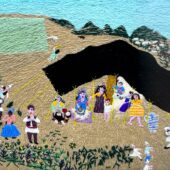Women’s Work
Women’s Work: From Craft to Fine Art, Reclaiming Arab Textile Art brings together the work of modern and contemporary Arab women artists, exploring the intersection of traditionally accepted female-coded craft practices and contemporary fine art.
Beyond their function as everyday objects in the Arab context, textiles in the region have acted as a tool to transmit knowledge, culture and identity intergenerationally. The artists featured in this exhibition have reclaimed and reimagined textile practices, elevating them beyond the confines of craft to challenge preconceived notions or art, identity and cultural heritage. Historically associated with female domestic labour, weaving and embroidery in these artworks are transformed into mediums for personal and social commentary. The artists in Women’s Work defy the notion of textile as purely decorative or utilitarian, whether knowingly or unknowingly.
The artworks in Women’s Work range from the 1950s to the 2020s and were created by artists from across the Arab world. These works are both deeply personal and socially engaged. The artists are not merely preserving tradition but are actively reshaping it for a contemporary context. In The Encounter of the First and Last Particles of Dust, Stephanie Saade explores the notion of displacement. The artist’s memories, linked to the embroidered trajectories on her family’s home curtains, intertwine personal stories with Lebanon’s history. Equally in The Weaver, Bouchra Khalili combines cotton with magnetic tape to highlight both weaving and video as techniques for intergenerational transmission of knowledge.
There are signs to be found in the more recent pieces that align with the global emergence of an appreciation for textile art since the late 2010s. As you move towards the more contemporary pieces they require less reclaiming, having been created with the confidence that they belong at the heart of the fine art world. The artworks exhibited in Women’s Work challenges us to reconsider how we define art and whose histories are worth preserving and honouring.















